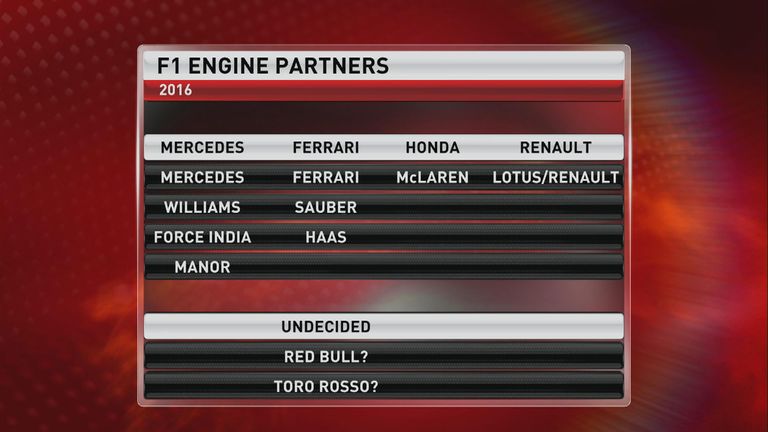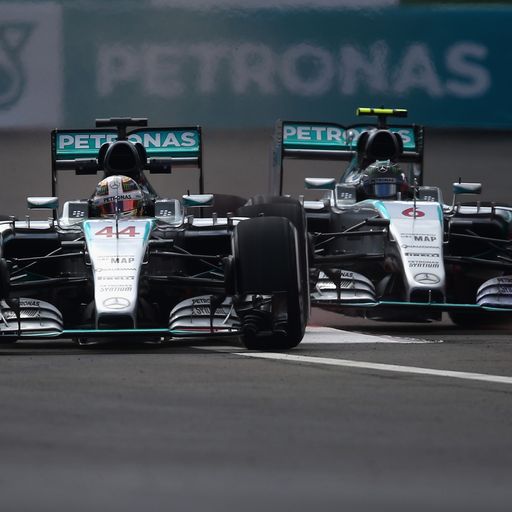Powering F1 for the future: Can budget engines bring value to F1?
Sky Sports F1 technical analyst Mark Hughes examines the viability of the sport introducing cheaper, 2.2-litre engines in 2017...
Monday 9 November 2015 18:31, UK
FIA President Jean Todt insisted in Mexico that in the ongoing engine discussions, he would prefer not to have to introduce an alternative 'low cost' 2.2-litre engine but would be quite prepared to if it came to it.
If the engine manufacturers cannot agree to supply the current hybrid 1.6 units for around half the price they currently charge, he will, he says, go ahead with the 'client engine' concept, with an accompanying 'balance of performance' equivalency formula.
This follows Ferrari using its infamous 'rules veto' at a recent engine manufacturers meeting where a motion was tabled to provide the hybrids for 12m euros per team per season (or 8m euros for a year-old spec) rather than the current 20m euros (actually between 18-24m euros, varying between each manufacturer).
Although the alternative 'client engine' is widely seen as just a theoretical stick with which to bring the engine manufacturers into line on prices, it could yet happen. Both Ferrari and Mercedes responded in Mexico that they could not supply their current engines at the price stipulated by Todt.
So, just how feasible would it be to introduce the 'client engine'? Should it go ahead, the FIA would ask for tenders from independent engine suppliers (such as Cosworth and Ilmor) to provide a 2.2-litre, twin-turbo V6. This, not coincidentally, is the same base specification as the current Indycar engine. Ilmor builds the Chevrolet-badged engine used in the American series and Honda produces its own. In Indycar these engines are limited to 12,000rpm, with boost levels controlled from race to race - to produce around 700 horsepower.
In order to be competitive, an F1 version of this engine would need to be delivering around 200 horsepower more than that. The Mercedes 1.6 hybrid is widely believed to be giving in excess of 900 horsepower, with the Ferrari not far behind. The 2.2-litre would use around 30 per cent more fuel and so would need to compensate for the greater starting weight of the fuel load (an extra 30kg equating to around one-second's-worth of weight) with yet-more power.
This is not foreseen to be a problem. The beauty of a race engine with 37.5 per cent greater capacity is that gains are relatively easier to make. With more boost, perhaps the addition of kinetic energy recovery systems (KERS) but not the expensive heat-recovery of the current engines, an F1 version of the Indycar engine could, say the engineers, comfortably be made more powerful than the current 1.6 hybrids - even without increasing the maximum revs. At a fraction of the cost.
In the case of Ilmor, the base engines already exist, so development cost would be purely that of making the necessary modifications. Cosworth is believed to have an Indycar engine ready to go at short notice should it find a customer so it too would probably be in a good position to make a competitive bid, should the FIA put out its invite for tenders.
This is not to trivialise the amount of work that would be required to adapt these engines, but it's not of an order that would present any significant engineering challenges to companies of the calibre of Ilmor or Cosworth. Just as in F1, the Indycar teams are limited to how many engines they can use in a season without penalty - in this case four per car.
As such, it has reliability margins built into its specification. So it's intrinsically a fairly robust design. Adding the required boost with the help of an intercooler and switching from ethanol to petrol would increase the cylinder pressures by something in the order of 30-35 per cent. The cylinder block, heads, crankshaft, rods and pistons of the Indycar engine can comfortably accommodate that, according to their designers. At the current 12,000rpm rev limit the valvetrain would need no revision - and that would be a boon in keeping development costs down.
Getting a precise equivalency with the current engines would, however, be close to impossible. There would be aerodynamic losses from the installation of a bigger engine to account for, the lap time losses from the greater fuel load would be variable (ie they'd be high at the start of the race, none by the end, and would be different from track-to-track) and even the differing traits of the two engine types would play out differently at each track, in each combination of weight and tyre performance.
The 2.2-litre engine would have more mechanical torque than the 1.6 but the latter would have more electrically-generated power (because it adds recovered thermal energy as well as braking energy). But the ways in which each of these are delivered is very different, with the electrical assistance hugely variable according to circuit layout. Any equivalency formula between the two types of engine would only ever be approximate - and would therefore always be the subject of controversy between the teams.
But long term it may be the only way in which the independent teams can stay in the game. To avoid the 'client engine' prospect, what Ferrari, Mercedes and Renault - the manufacturers of the currently commercially available hybrid engines - need to take into account in their costings is the subsidy necessary to ensure they still have someone to beat.
MH






